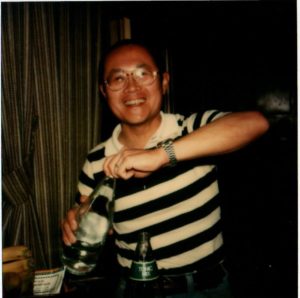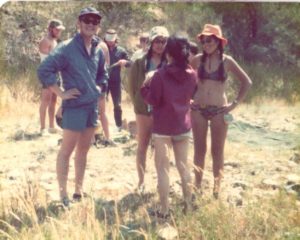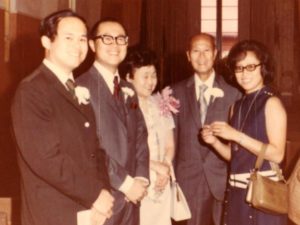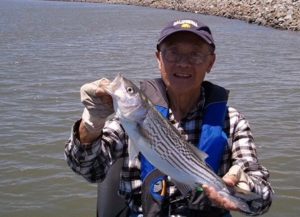
Dennis Tom, New Year’s 1980
Last month, my uncle Dennis Tom passed. As I reflect upon who he was and how he lived, I realize that he was a uniquely humble, happy and unassuming person. He lived life effortlessly and with grace despite years of difficult health conditions for both himself and wife Elinor.
Where many would have been down-trodden, he was always positive and good natured. No matter what the current circumstance, he would always greet me with a big grin asking, “Hey Stevereeno, been fishing lately?” In later years as his short-term memory failed, he’d ask me that question time and time again, sometimes only minutes apart. But every time, it was music to my ears. It was a throwback to all the good times we shared as family.
Our families always spent holidays, birthdays and other monumental events together. And our parents traded kids whenever they traveled. Imagine Uncle Den and Aunty Ellie followed by 6 boys and a girl. I’m sure that was quite a sight, especially given how petite and young Aunty looked. Ditto when my Mom took all the kids.
When I reached driving age, I was invited to go on vacations with the Toms. I fondly recall the time I met them at Don Pedro Reservoir for a week of white bass fishing. It amazed me how Uncle Den could simply drop his boat into a never seen lake and slay a mess of fish. I also remember what a trooper Aunty was as she huddled under the boat deck by day (trying to keep warm) and cleaned up after 5 men/boys by night. Meanwhile, Uncle Den was equally busy teaching us to fish by day and frog by night. To this day, I’ve never had a frog leg I liked as much as Aunty Ellie’s.
To make things ethnically fair, we also slayed countless black bass up in Sacramento (sorry, bad joke… but if there were yellow bass, we surely would have fished them too… actually, one time Randy, Cherri, Karen and I fished peacock bass, a rainbow kind of bass in Hawaii… but that’s another story…). Anyways, plugging for bass is all about skill and Uncle Den was the master of it: he always knew where the fish were and could whack them on the head with his lure every time. There was no mystery as to why he always got the most and the biggest fish. One time, on his last, last, last, last, last cast, he hooked up. It was big. And it ran deep. So there we were, heading out into the main channel at dusk following the fish downstream. Other boats took notice and followed, witnessing a 20-minute battle that ended in a triumphant boating of a 12lb striped bass ~ a nice bonus to two limits of black bass that were already in the live well. Vintage Uncle Den.
On the subject of striped bass, we also spent years of party boat fishing in the San Francisco Bay. From the beaches outside the bay to California City to the South Tower under the Golden Gate Bridge, Uncle Den knew exactly how to work each and every patch of water. For example, when I was a young teen, he taught me the exact location of the South Tower anti-submarine cables. His secret was to drop his line to a certain depth as the boat floated past the tower, hold that depth until a certain marker was passed, then let the line down as fast as possible to hit a sweet spot that was always loaded with fish. When the fish were in, a boat would only take a few passes through the area before making limits, so you needed to hook up fast or else you’d receive someone else’s smaller fish after they limited out. Uncle Den was always hooked up and always culling fish to others.

Left to Right: Dennis Tom, Darlene Sue, Sandy Tom, Elinor Tom (back to camera). Stanislaus River, CA 1973
He even hooked up when there were supposedly no fish. Once, on a two-day trip down the Stanislaus River, he asked if there were any fish in the river. With strong conviction, the river guides said, “No. We’ve never seen a fish caught out of this river.” So of course on the overnight stop, he whipped out his rod, stalked a large pool and landed a 4lb brown trout an hour later. I remember when he hooked up. He thought it was a snag and was walking down river to pull his line free. Then it moved. The next year when we went on the same trip, a different set of guides were boasting about some guy who caught a monster the year before. LOL. That became even funnier when he landed a 3lb rainbow trout at the same spot then fessed up that he was the guy from the year before. If you don’t know about trout, those would be considered trophy size, suitable for stuffing and hanging on a wall to signify a great conquest. Being Chinese, we of course ate them instead.
Yes, fishing was so much of our upbringing. And Uncle Den was always at the center of it. We also spent years fishing for shad in Sacramento at the “Minnow Hole.” For years, we took sacks of those boney fish from that river… all smoked later for eating. I also remember when I was quite young, our families went to San Diego on vacation. He and my Dad went out on a charter fishing boat. My Dad got sea sick and Uncle Den caught a huge barracuda. No surprise. What was surprising was that they came back and put it in our motel bathtub. Even more surprising, we brought the fish to a Chinese restaurant for dinner and asked them to cook it for us. But I guess they weren’t that Chinese as they refused to cook it. So we walked out leaving the fish there. I remember thinking in my little child head that the circumstance was truly tragic. A fish caught the you couldn’t eat. I wanted to cry. May be bringing raw fish to Chinese restaurants is a Northern California thing.
Back in Northern California, I remember he always had black bass for restaurants to cook for our family dinners. There could be 10 tables at a banquet and he was always able to produce fish to go around. I remember heading to Sacramento with him several times with the mission of catching that elusive gamefish for a family event. Restaurant staffs would always admire the size of his fish, noting that black bass were hard to get and the most sought after kind of fish by Chinese. They even nicknamed him “Black Bass” in Chinese.
But his sportsmanship wasn’t just about fishing. He was an ardent Cal Football fan. Go Cal! And he was a great tennis player. For years, he and I had an on-going tennis match. We were really close in skill level so we always had knock-down, drag-outs at his tennis club. Our tradition was that I’d head to his house, we’d roll to his club from there, play a few sets and roll back to his place for dinner with the family, then watch sports on TV.
Sports like tennis can be quite telling of a person’s demeanor and personality. In the heat of the moment, pride, humility, anger and other emotions/traits, mostly negative, become transparent. If you suck but you’re trying to puff that you’re better than your current performance, everyone still sees that you suck. If you’re really good, but are merciful, everyone sees that too. Our match went on for years and never once did I see him angry, posturing, unrealistic or with excuses. He just loved playing and enjoyed the beauty of a good shot whether he or his opponent made the shot.

Left to Right: Duane Tom, Dennis Tom, Dorothy Tom, Yim Tom, Darlene Tom Sue at Duane & Sandy’s wedding, June 1970
What I saw on the tennis court was also brought home to his own backyard. One summer, he had my brother Alan (now “AJ”) and I build a deck with a redwood hot tub in his backyard. In retrospect, it’s a huge statement to let a couple of high school and middle school kids build a massive wood structure to hold thousands of gallons of water on your property. Thank God it never busted. But I think it turned out well. Besides, we had the backup of my Dad who looked over our shoulders and later while his guys did the landscaping, probably added a nail of two. After that, Uncle Den installed a sports court for paddle ball (a mini version of tennis). For decades, that backyard was the hit of family summer time events.
All those years, he provided, taught and supported all of us. He was always one with a kind smile. Never proud. Always humble. That despite having a huge house, in a fancy neighborhood, a beautiful family and a successful pharmaceutical practice.
In the really old days, I recall spending time at his pharmacy in Alameda. Pharmacies have a distinct smell. To me, it smelled like caring. But it wasn’t just the smell. It was the people. You could tell that he cared for his staff like another family. Also noteworthy was that he typed. Typing: as in a typewriter with an ink ribbon. In those days, the “delete” button didn’t exist so proficiency and accuracy was key. He would stand there in his white pharmacist coat and pound out prescription labels like there was no tomorrow. A man that could type. On a typewriter. With pure confidence. With no secretary. He was a modern man in an ancient era.

Last Keeper (With Randy Tom). June 1, 2013
But that era has passed. It was one marked by a true gentleman who lived large and with grace.
Uncle Den: I thank you for being such a huge part of my life. We did it all. And I look forward to the day when we can fish, play tennis and BBQ together again. Until then, please know that you’re one of my heroes. May you rest in peace.





 “Bill King (1916 -2002), a third generation American-born Chinese, volunteered to y for the Chinese Air Force in World War II and was assigned to the Chinese American Composite Wing (CACW) of the 14th Air Force. He was a highly decorated Flying Tiger pilot.
“Bill King (1916 -2002), a third generation American-born Chinese, volunteered to y for the Chinese Air Force in World War II and was assigned to the Chinese American Composite Wing (CACW) of the 14th Air Force. He was a highly decorated Flying Tiger pilot. ‘Jim King’, Bill King’s grandfather, Jow Kee or Chow Yook Kee (1840-unk) came to San Francisco from Zhongshan, Guangdong Province, in 1855 when he was 16. He found a job with gold miners who liked him, taught him English, and gave him an American name – Jim King. Knowing English, he went to work as a foreman and labor contractor for the Central Pacific Railroad building the western end of the transcontinental railroad. The payroll records of the Central Pacific Railroad in January 1866 show the listing of Jim King, Contracting Co. After completion of the transcontinental railroad, King continued as a labor contractor, hiring former railroad workers and other workers from his home village, for the Sacramento River levee construction. After clamshell dredgers displaced the workers, they became agricultural workers in the region and King became a tenant farmer. He married Hel Shee, whom he met in San Francisco. They settled in a farmhouse in the Delta and had eight children.
‘Jim King’, Bill King’s grandfather, Jow Kee or Chow Yook Kee (1840-unk) came to San Francisco from Zhongshan, Guangdong Province, in 1855 when he was 16. He found a job with gold miners who liked him, taught him English, and gave him an American name – Jim King. Knowing English, he went to work as a foreman and labor contractor for the Central Pacific Railroad building the western end of the transcontinental railroad. The payroll records of the Central Pacific Railroad in January 1866 show the listing of Jim King, Contracting Co. After completion of the transcontinental railroad, King continued as a labor contractor, hiring former railroad workers and other workers from his home village, for the Sacramento River levee construction. After clamshell dredgers displaced the workers, they became agricultural workers in the region and King became a tenant farmer. He married Hel Shee, whom he met in San Francisco. They settled in a farmhouse in the Delta and had eight children. ll King was highly decorated…”
ll King was highly decorated…” Hey 6584 fans! Our new friends Michael Rubin & Jessica Barksdale, the current owners of 6584 contacted us through NiceyRicey this week. Thx Michael and Jessica for stalking us! Michael and Jessica relatively newlyweds (5 years) who purchased 6584 a couple years ago and have done some really nice remodeling.
Hey 6584 fans! Our new friends Michael Rubin & Jessica Barksdale, the current owners of 6584 contacted us through NiceyRicey this week. Thx Michael and Jessica for stalking us! Michael and Jessica relatively newlyweds (5 years) who purchased 6584 a couple years ago and have done some really nice remodeling.